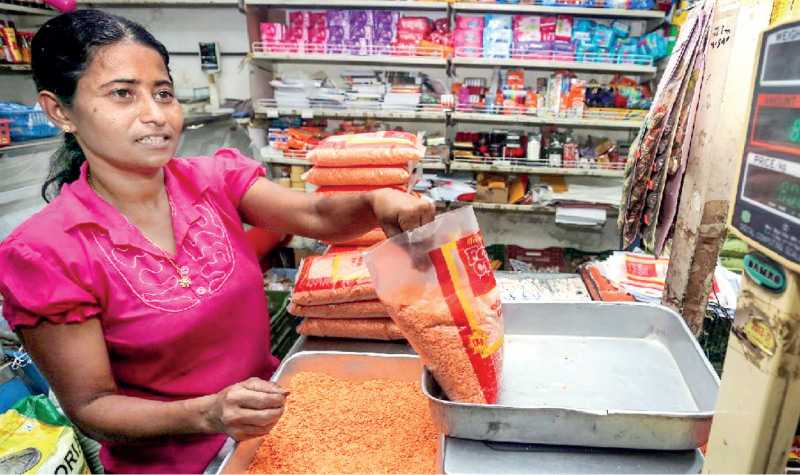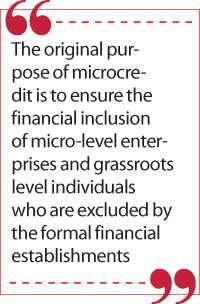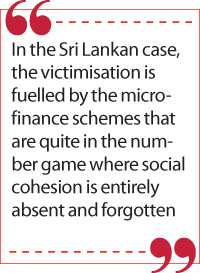Sunday Apr 13, 2025
Sunday Apr 13, 2025
Wednesday, 31 March 2021 00:00 - - {{hitsCtrl.values.hits}}

As per the statistics of the Microfinance Barometer, 65% of the world microfinance borrowers have been people who do not have access to formal financial establishments. There is no question of such an approach with the limited access that formal financial institutions can offer
 Irrespective of the fairy anecdotes on the gospel sovereignty of microcredit programmes of denting poverty, there are growing doubts on sustaining their core – enhancing financial inclusion for the poor to find a way out from financial poverty.
Irrespective of the fairy anecdotes on the gospel sovereignty of microcredit programmes of denting poverty, there are growing doubts on sustaining their core – enhancing financial inclusion for the poor to find a way out from financial poverty.
From its authentic core to empower rural communities via increased financial inclusion, microlending has grown into a massive trade by now under the tag of ‘responsible financing’. Thus, the approach has received immense popularity with its authentic roots of promoting the equal right for capital regardless of income levels. As per Microfinance Barometer (2019), there are approximately 140 million borrowers worldwide where 80% of them are women.
Is it a fallen angel?
Even amid the approaches’ swelling glory, can the world boast about the superpower of microcredit as a sustainable resolution for denting poverty? Can we boast on microcredit as a system detoxifier combating the prevailing political cacophonies? These concerns heed calls for analysing, thinking and designing the schemes on a whole different level.
The symptoms of the approach’s malaise are getting deeper day by day predominantly in developing nations such as Sri Lanka – the mounting number of suicide cases, growing number of protests against microcredit institutions, swelling trend of establishment of associations by victims of microcredit (especially in rural areas) and protesting campaigns against ruthless exploitation of poor are some of them.
Taking a stand against the ruthless exploitations of rural communities, even at the very moment I’m writing this article, there is a huge women movement at Hingurakgoda bringing together many rural victims of microfinance schemes. One fact is palpable – Microcredit isn’t any longer the same seraph that appeared to crack the poverty trap in the world 30 years ago!
The majority of the concurrent microcredit schemes have lost their authentic purpose of warranting financial inclusion, rather grown into deep sinking debt traps for the poor. This brings me to Christian mythos where demons are viewed as fallen angels where even Satan is supposed to be an angel who was expelled from heaven. Consequently, is microcredit a fallen angel?
Therefore, this article offers some vital insights on the depth of the matter while reasoning out why the victims are in dire straits. The insights were gathered from interviewing several victims. So, let us have some insights into the matter.
 Microcredit: The dark side of the moon
Microcredit: The dark side of the moon
Why do most rural communities relying upon microcredit end up with doom and gloom tangling themselves in unfathomable debt traps?
Straying away from the authentic purpose – an ‘illusory victory’ for the poor?
The original purpose of microcredit is to ensure the financial inclusion of micro-level enterprises and grassroots level individuals who are excluded by the formal financial establishments. Subsequently, by default, microcredit institutions are supposed to be hybrid organisations, which emphasises that they are bound to enhance financial inclusion for the poor while staying sustainable.
As per the statistics of the Microfinance Barometer, 65% of the world microfinance borrowers have been people who do not have access to formal financial establishments. There is no question of such an approach with the limited access that formal financial institutions can offer. According to Global Findex Database (2018), less than 20% of borrowers have access to traditional financial establishments.
The booming industry has created a cut-throat competition among financial institutions where the institutions are chasing the numbers instead of creating social impact.
As per the investigations on the Sri Lankan microfinancing sector by Bohoslavsky (2018) who is a United Nation’s independent expert, loan charges in microfinance institutions have been rocked up to 220% of interest rates where compound interest rates are applied. This is a clear indication that the microfinance establishments are behind financial economics rather than human economics.
Therefore, it is questionable whether microfinance is an ‘illusory victory’ for the poor who are excluded by the formal financial establishments.
 Lending without building the business immunity: A predictable train wreck?
Lending without building the business immunity: A predictable train wreck?
Specifically, are there any mechanisms to pick these micropreneurs and the rural communities up at the falls and allowing them to move on? Most of the micropreneurs who have fallen victims lack even the basic literacy of building and handling a business.
They lack the knowledge on how to keep transactions, financial records, identifying potential market opportunities to boost the cashflows, manage working capital, and most importantly, new capital formation. Their poor business and financial literacy have been the starting point of falling into a debt trap. However, is it fair to blame their business failures? Microcredit programs in Sri Lanka prove that lending with no strings attached cause chaos.
It’s the traditional belief that the failures are ‘bad’. However, even the well-reputed corporates provide shreds of evidence that failures provide priceless learning insights to rise back and shine. As emphasised by Margaret Thatcher: “You have to fight a battle more than once to win it.” The problem here is that no attention is devoted to helping the victims to rise back when the fall.
The basic experiments done in the different country contexts such as Indonesia, Namibia, South Africa and other country contexts have proven that building business immunity among rural communities simultaneously with lending would certainly prop up micropreneurs by creating a way from bitter to better. This requires microcredit schemes in Sri Lanka to re-strategising their operational and delivery strategy.
Turning into a cycle of over-indebtedness: Out of the frying pan, into the fire?
In the Sri Lankan case, the victimisation is fuelled by the microfinance schemes that are quite in the number game where social cohesion is entirely absent and forgotten.
The common issue observed among the victims is they have borrowed money mainly for consumption leading to more borrowings for paying back the loans which have trapped them in deep loan traps. As a result, many of the victims have used the debts for consumption which allow them to reap zero return on capital.
Additionally, most of the victims are with multiple loans quite disproportionate to their income levels. It becomes disastrous amid idiosyncratic shocks leading the debt load unmanageable specifically when they have to devote their all monthly income for monthly instalments.
The worst part comes with borrowing at double-digit interest rates which further tie them up strongly into the debt trap. These settings surely create a situation out of the frying pan, into the fire. The signals are pretty strong in the Sri Lankan context – around 200 suicide cases in the last two to three years due to debt-induced distress.
Conclusion: Any way out from bitter to better?
The whole purpose of this article is not to stress that microfinance has to be abolished or eliminated. However, it’s high time to set up proactive mechanisms to create a conducive environment for playing square where the poor can reach the benefits rather than felling victims to the schemes.
The snowballing protesting movements could be just the tip of the iceberg. The situation shows how far that the microcredit schemes have morphed away from their authentic persistence leaving so many underprivileged in distress.
To conclude, what could be the solution if the microcredit schemes go astray? Looking at the bright side, for microcredit, this is not a fall at the final hurdle and there is an immense likelihood to make a comeback via effective policy interventions.
Hence, it is high time for policymakers to formulate policies to warrant responsible financing before many poor steps into deep debt traps. Only such an approach could bring up the ‘human economic’ perspective which is the authentic purpose of microcredit schemes to exist in lieu of the ‘profit economic’ standpoint. If not, ‘the financial inclusion for poor’ via microcredit would be just one more pie-in-the-sky
fantasy!
(The writer is a senior lecturer in Entrepreneurship at Department of Management Sciences, Faculty of Management, Uva Wellassa University of Sri Lanka and can be reached via [email protected].)
Discover Kapruka, the leading online shopping platform in Sri Lanka, where you can conveniently send Gifts and Flowers to your loved ones for any event including Valentine ’s Day. Explore a wide range of popular Shopping Categories on Kapruka, including Toys, Groceries, Electronics, Birthday Cakes, Fruits, Chocolates, Flower Bouquets, Clothing, Watches, Lingerie, Gift Sets and Jewellery. Also if you’re interested in selling with Kapruka, Partner Central by Kapruka is the best solution to start with. Moreover, through Kapruka Global Shop, you can also enjoy the convenience of purchasing products from renowned platforms like Amazon and eBay and have them delivered to Sri Lanka.
Discover Kapruka, the leading online shopping platform in Sri Lanka, where you can conveniently send Gifts and Flowers to your loved ones for any event including Valentine ’s Day. Explore a wide range of popular Shopping Categories on Kapruka, including Toys, Groceries, Electronics, Birthday Cakes, Fruits, Chocolates, Flower Bouquets, Clothing, Watches, Lingerie, Gift Sets and Jewellery. Also if you’re interested in selling with Kapruka, Partner Central by Kapruka is the best solution to start with. Moreover, through Kapruka Global Shop, you can also enjoy the convenience of purchasing products from renowned platforms like Amazon and eBay and have them delivered to Sri Lanka.